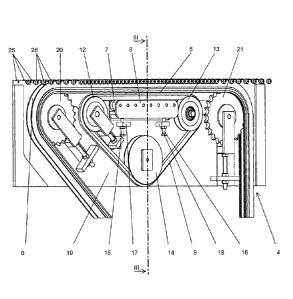Some of the information on this Web page has been provided by external sources. The Government of Canada is not responsible for the accuracy, reliability or currency of the information supplied by external sources. Users wishing to rely upon this information should consult directly with the source of the information. Content provided by external sources is not subject to official languages, privacy and accessibility requirements.
Any discrepancies in the text and image of the Claims and Abstract are due to differing posting times. Text of the Claims and Abstract are posted:
| (12) Patent: | (11) CA 2997633 |
|---|---|
| (54) English Title: | DEVICE FOR DRIVING A HANDRAIL |
| (54) French Title: | DISPOSITIF D'ENTRAINEMENT D'UNE MAIN COURANTE |
| Status: | Granted |
| (51) International Patent Classification (IPC): |
|
|---|---|
| (72) Inventors : |
|
| (73) Owners : |
|
| (71) Applicants : |
|
| (74) Agent: | SMART & BIGGAR LP |
| (74) Associate agent: | |
| (45) Issued: | 2019-11-05 |
| (86) PCT Filing Date: | 2016-09-19 |
| (87) Open to Public Inspection: | 2017-03-23 |
| Examination requested: | 2018-03-06 |
| Availability of licence: | N/A |
| (25) Language of filing: | English |
| Patent Cooperation Treaty (PCT): | Yes |
|---|---|
| (86) PCT Filing Number: | PCT/AT2016/000083 |
| (87) International Publication Number: | WO2017/044996 |
| (85) National Entry: | 2018-03-06 |
| (30) Application Priority Data: | ||||||
|---|---|---|---|---|---|---|
|
A device for driving a handrail (1) of a passenger conveyor comprises an endless driven element (4) that is driven by a motor (11). Support rolls (7) are arranged on the side of the driven element (4) which lies opposite the handrail (1), and the driven element (4) is supported on the support rolls (7) via a belt (9).
La présente invention concerne un dispositif d'entraînement d'une main-courante (1) d'un dispositif de transport de personnes, qui comporte un élément d'entraînement (4) sans fin entraîné par un moteur (11). Des galets de support (7) sont disposés du côté de l'élément d'entraînement (4) qui est opposé à la main courante (1), et l'élément d'entraînement (4) s'appuie sur les galets de support (7) par lîntermédiaire d'une courroie (9).
Note: Claims are shown in the official language in which they were submitted.
Note: Descriptions are shown in the official language in which they were submitted.

For a clearer understanding of the status of the application/patent presented on this page, the site Disclaimer , as well as the definitions for Patent , Administrative Status , Maintenance Fee and Payment History should be consulted.
| Title | Date |
|---|---|
| Forecasted Issue Date | 2019-11-05 |
| (86) PCT Filing Date | 2016-09-19 |
| (87) PCT Publication Date | 2017-03-23 |
| (85) National Entry | 2018-03-06 |
| Examination Requested | 2018-03-06 |
| (45) Issued | 2019-11-05 |
There is no abandonment history.
Last Payment of $203.59 was received on 2022-09-05
Upcoming maintenance fee amounts
| Description | Date | Amount |
|---|---|---|
| Next Payment if small entity fee | 2023-09-19 | $100.00 |
| Next Payment if standard fee | 2023-09-19 | $277.00 |
Note : If the full payment has not been received on or before the date indicated, a further fee may be required which may be one of the following
Patent fees are adjusted on the 1st of January every year. The amounts above are the current amounts if received by December 31 of the current year.
Please refer to the CIPO
Patent Fees
web page to see all current fee amounts.
| Fee Type | Anniversary Year | Due Date | Amount Paid | Paid Date |
|---|---|---|---|---|
| Request for Examination | $800.00 | 2018-03-06 | ||
| Application Fee | $400.00 | 2018-03-06 | ||
| Maintenance Fee - Application - New Act | 2 | 2018-09-19 | $100.00 | 2018-08-15 |
| Maintenance Fee - Application - New Act | 3 | 2019-09-19 | $100.00 | 2019-08-07 |
| Final Fee | $300.00 | 2019-09-13 | ||
| Maintenance Fee - Patent - New Act | 4 | 2020-09-21 | $100.00 | 2020-09-09 |
| Maintenance Fee - Patent - New Act | 5 | 2021-09-20 | $204.00 | 2021-09-06 |
| Maintenance Fee - Patent - New Act | 6 | 2022-09-19 | $203.59 | 2022-09-05 |
Note: Records showing the ownership history in alphabetical order.
| Current Owners on Record |
|---|
| INNOVA PATENT GMBH |
| Past Owners on Record |
|---|
| None |